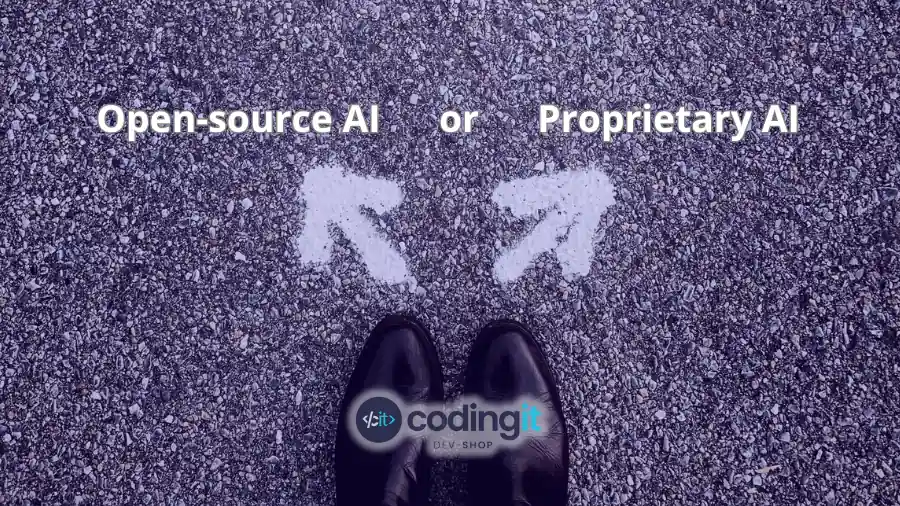We know you entered this blog not wondering whether to use AI in your product. You have already decided that. You’re here trying to make it work. You’ve probably already shipped a few features, played with some APIs, or at least sketched out where AI fits into your roadmap. Which means you’re past the “let’s explore AI” phase and deep into the part where architectural choices start to matter.
Sadly, this is where the initial excitement usually meets its first brick wall. Because once you move past the demo stage, the landscape shifts. Some models come wrapped in polished APIs with zero visibility under the hood. Others are open-weight, flexible, and… kind of your problem to manage. Some options are fast to integrate but come with long-term costs. Others give you control, but expect you to bring infrastructure, ML talent, and patience.
It’s not just a technical fork in the road anymore. It’s a product, team, and budget decision.
So no, this isn’t a think piece about “the future of AI” or a nostalgic rant about open-source purity. It’s a practical breakdown for those who need to decide how they’re going to build (and ship) with AI and focus on the real challenge: Choosing which version of it fits your product without boxing you in later.
Blog Summary:
Navigating the AI model maze by understanding what control means, what risks lurk beneath easy integrations, and how to future-proof your product. Here’s a taste of what you’ll get in this blog post:
- Why “open-source” isn’t as simple as it sounds.
- The costs behind proprietary AI services that no one talks about upfront.
- How to spot when convenience could become a costly cage.
- What most teams miss when they assume switching AI providers will be easy.
- Why your team’s skills and your product’s role in the market should shape your AI choices.
- Ways to build flexibility into your AI stack so you’re ready for whatever’s next.

Table of Contents:
What Open-Source AI Offers
“Open-source AI” sounds straightforward. It’s not. For those new to the space, the term can be misleading. It doesn’t mean free to use, easy to deploy, or ready to ship. And it definitely doesn’t mean you get a drop-in replacement for GPT-4 sitting in a public repo.
What you get is access. To the model weights, the training architecture, and often the community, trying to make it better. You can inspect how it was built. You can fine-tune it for your use case. You can host it where you want, run it offline, or plug it into a stack that makes sense for your business. That level of control is the whole point.
But it comes at a cost. Most open-source models aren’t wrapped in polished tooling. If you’re expecting API docs and uptime guarantees, you’re looking in the wrong place. Getting an open model into production typically involves a combination of infrastructure decisions, performance tuning, and dependency management. Some projects make this easier, but there’s still work to do.
Another thing worth saying: open-source doesn’t mean outdated. The gap between top proprietary and open models is closing fast. You won’t always need “the best model on the planet” to deliver a great experience. In many use cases, smaller, cheaper, more controllable models win.
Open-Source Doesn’t Mean Starting from Zero
There’s a misconception that choosing open-source AI means building everything yourself. Going from training data to hosting infrastructure. And that’s outdated thinking.
Today’s open models come with pre-trained weights, solid documentation, and increasingly, managed platforms that handle the heavy lifting. You don’t have to be an ML wizard with a server farm to get started. Services like Hugging Face, Replicate, or Gradient let you deploy and fine-tune models without managing raw infrastructure.
The payoff is real control: no surprises in pricing, no hidden black boxes, and the freedom to tweak models to your product’s unique needs. Plus, when you control your stack, you’re less exposed to sudden vendor policy changes.
What Proprietary AI Offers
If you’ve used OpenAI, Claude, or Gemini, you already know the appeal. You get fast results, high-quality responses, and a clean developer experience. No hosting, no ops, no tuning. Just an API key and a credit card. That’s hard to beat when you’re trying to move quickly.
Proprietary models offer speed, stability, and maturity. You get performance that’s hard to match out of the box, plus teams of engineers keeping it reliable. For many founders, that’s exactly what they need. Especially early on.
But this path has tradeoffs. You don’t get visibility into how the model was trained, what data it saw, or how it handles edge cases. You’re betting on someone else’s plan. You’re paying for improvements you didn’t ask for and might not need. And if pricing or policies change, you don’t have a lot of leverage.
Integration is fast, sure, but replacing it later is not. The more core your AI use case becomes, the more that lock-in matters. But if AI is playing a supporting role, and you need something that “just works,” this route can still make sense.

The Lock-In Problem
Most teams don’t notice lock-in right away. You deploy a feature that works, users like it, and you move on. But as AI becomes more embedded, swapping out the underlying model starts to feel like pulling teeth.
Prompts are carefully engineered for one provider’s quirks. The user interface adapts to specific response behaviors. Costs and performance assumptions get baked into your business model. And every time you consider a change, you’re faced with a cascade of retesting, retraining, and sometimes redesigning core flows.
This impacts product velocity and strategic flexibility. You risk becoming hostage to pricing changes, roadmap shifts, or even a vendor’s shutdown. Lock-in can be a conscious trade-off. Paying a premium to move fast and avoid complexity. But ignoring it means losing options without realizing it.
That’s why planning for lock-in means managing risk. Building abstraction layers, keeping prompt templates modular, and architecting your code so you can swap providers when needed.
Open models can play a role here, even if you don’t deploy them immediately. They offer an alternative path when contracts tighten or your priorities shift. Maintaining that fallback keeps your future open, not boxed in.
Choose Based on Use Case, Not Ideology
The debate between open-source and proprietary AI often gets framed as a battle of principles. But when you are building your ideal products, ideology isn’t the point. The focus should be on what your product needs, how your team works, and what risks you can absorb.
Start by looking at your AI feature’s role. If it’s core to your user experience, you’ll want more control over the model’s behavior, performance, and cost. Open-source gives you that flexibility.
If AI is an add-on, something that smooths workflows or automates small tasks, proprietary APIs might be a better fit. You’ll trade some control for speed and simplicity, which can be a smart move when you want to focus on other parts of your product.
Beyond product fit, consider your team’s expertise and infrastructure. Open-source demands ML and ops capabilities. If those resources aren’t in place, you risk bottlenecks and burnout. Proprietary vendors shoulder much of that burden, letting your team concentrate on features and user feedback.
Security and compliance also play a role. Some industries need full data control or must comply with strict regulations. Hosting your model can simplify audits and data governance. Proprietary models may raise questions around data usage, retention, or exposure that aren’t trivial to resolve.
And always think long term. Your use case might evolve, and today’s side feature could become tomorrow’s core. Choose options that keep your architecture flexible enough to pivot, or plan for a hybrid approach that blends both models where it makes sense.
Beyond just picking a model, understanding the real impact of AI on your business is crucial. If you want to dig into how to measure AI ROI beyond the usual metrics, our article on Redefining AI ROI breaks down what moves the needle.
Founders’ Blind Spots
Even the savviest founders can trip up on this decision. Not because of their lack of intelligence or experience, but because some risks and costs aren’t obvious upfront, and the AI landscape moves fast.
One big blind spot is underestimating infrastructure complexity with open-source models. It’s easy to assume “it’s just code” and forget the engineering needed to keep it running smoothly, scale it under load, and handle monitoring and incident response. Those hidden costs quickly pile up.
On the flip side, many overestimate how stable and predictable proprietary vendors are. Pricing models change, APIs get deprecated, and terms of service shift with little warning. Betting the core product on a third party without fallback plans is a risk many don’t factor in until it’s too late.
Latency surprises catch people off guard, too. What works well in a test environment might not hold up under real user load or strict performance SLAs. If the AI feature is customer-facing, that lag directly hits user satisfaction.
And you can’t treat an AI model choice like a one-time decision. The truth is that it’s iterative. Models improve, new players emerge, and your product needs evolve. Building architecture that anticipates change (rather than hardcoding dependencies) makes all the difference.
Some might miss how scaling usage impacts cost and complexity. A feature that seems cheap at pilot scale can explode expenses once adoption grows, especially with proprietary APIs charging per token or request. Being aware of these blind spots and planning for them lets you avoid surprises that slow down your roadmap or hurt your product’s reliability.
Decision Framework
Choosing between open-source and proprietary AI isn’t a quiz with a correct answer. It’s more like system design: you weigh trade-offs, scope constraints, and future needs. If you only need to take one thing from this blog, force the decision out of abstraction and into real conditions.
Try framing the question like this:
- If this model fails tomorrow, what breaks?
- If costs double, what changes?
- If your growth triples, what struggles to keep up?
Questions like these reveal which variables matter most to your business. Cost predictability, performance control, speed of iteration, vendor stability, and compliance posture. They also highlight where your team might need scaffolding or where you’re ready to take on more ownership.
We work with teams who are deep in these questions, not trying to catch the next AI trend, but trying to build software that lasts. If you’re in the thick of it and want to pressure-test your assumptions, we’d be happy to join the conversation.
These decisions aren’t easy, and the right path depends heavily on your team’s expertise and long-term goals. If you want to pressure-test your assumptions or need help charting a clear course through the AI landscape, our AI Consulting Services specializes in guiding you through these exact questions.
